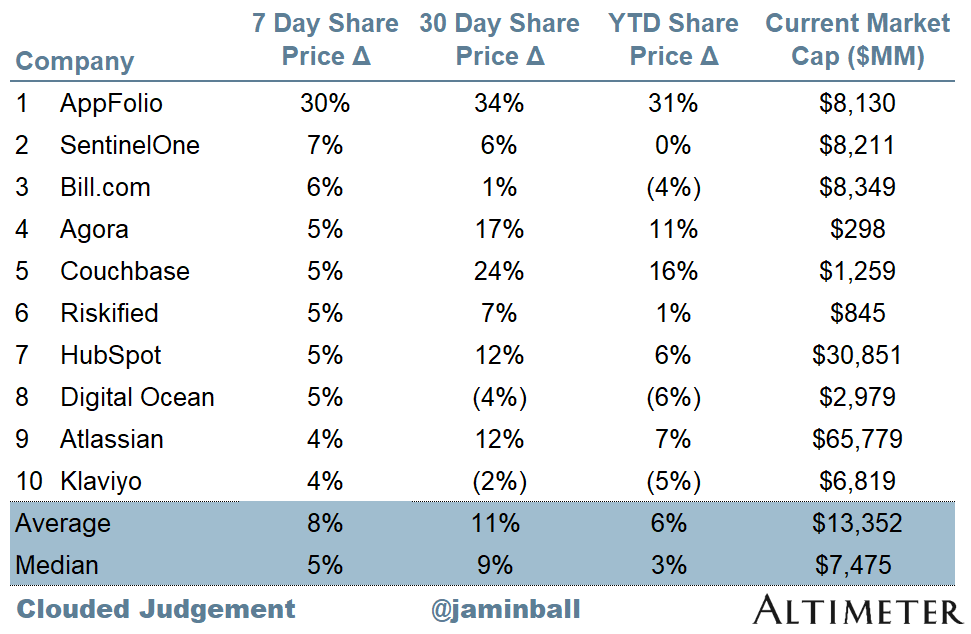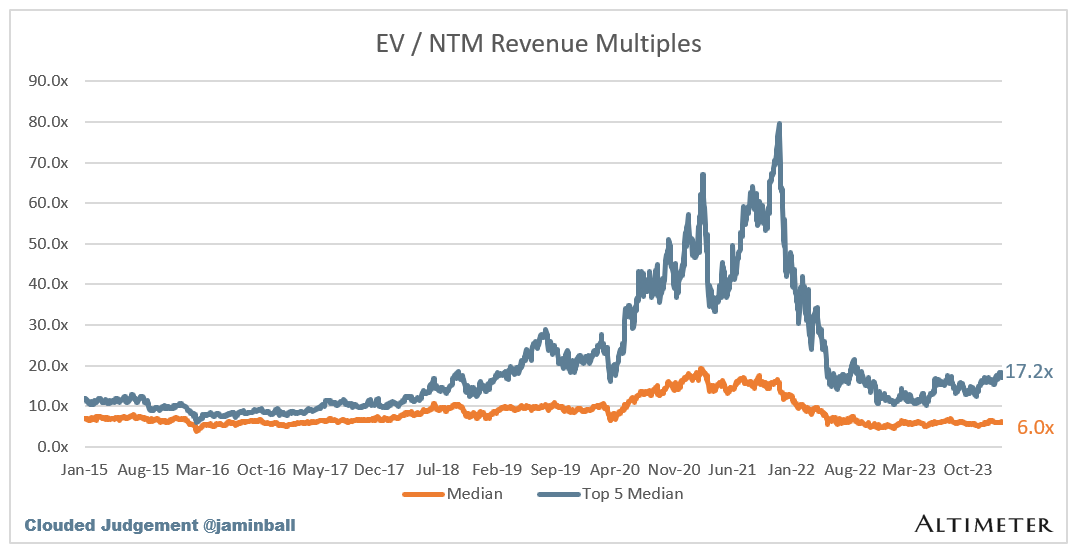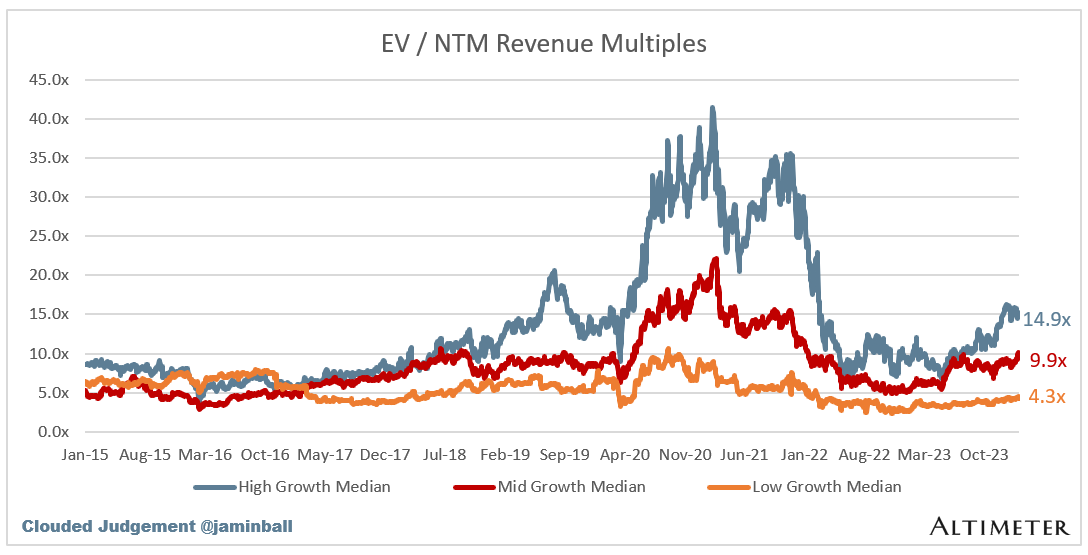Every week I’ll provide updates on the latest trends in cloud software companies. Follow along to stay up to date!
Cloud Giants Report Q4 ‘23
A couple quotes from the Amazon, Microsoft and Google earnings call really stood out to me this week.
Amazon on AWS: “…customers are continuing to shift their focus towards driving innovation and bringing new workloads to the cloud. Similar to what we shared last quarter, we continue to see the diminishing impact of cost optimizations. And as these optimization slow down, we're seeing more companies turning their attention to newer initiatives and reaccelerating existing migrations.”
Microsoft on Azure: “And I think last quarter, we said one, we are going to continue to have these cycles where people will build new workloads. They will optimize the workloads and they'll start new workloads. So I think that, that's what we continue to see. But that period of massive, I'll call it, optimization only and no new workload start, that, I think, has ended at this point. So what you're seeing is much more of that continuous cycles by customers, both when it comes to AI or whether it comes to the traditional workloads.”
Google on Google Cloud: “I think there are regional variations, but the cost optimizations in many parts are something we have mostly worked through.”
What’s the TLDR? The hyperscalers are really starting to see the tailwind of new workload growth overtake the headwind of optimizations. Sometimes new workloads are AI related. Sometimes they’re classic cloud migrations. The hyperscalers benefit from massive scale, distribution, trust and depth of customer relationships in ways no other software companies do. They also are seeing AI revenue (largely compute) show up sooner than anyone else. So it’s fair to question whether the strength in hyperscalers flows through to the rest of software. Azure (excluding Azure AI) continued to decelerate, and while AWS did come in ahead of expectations, it wasn’t a blow out. I’d say both of the “non AI” Azure / AWS figures weren’t actually that strong? We’ll see starting next week how the broader software universe performs when they start to report Q4s, but I’m not sure the strength in hyperscalers can really be seen as an “all clear” for the rest of software, given the hyperscalers uniquely benefit from AI.
Here’s the broad update on each:
AWS (Amazon): $97B run rate growing 13% YoY (last Q grew 12%)
Azure (Microsoft): ~$74B run rate (estimate) growing 28% YoY (last Q grew 28%)
Google Cloud (includes GSuite): $37B run rate growing 26% YoY (last Q grew 22%, neither are cc)
And below are the YoY growth rates for each
The next set of charts show the quarterly net new ARR added by each
And the final set of charts show the YoY growth rate in quarterly net new ARR added. AWS has quite the recovery graphic
If you want all of those charts in one image, I’ve combined everything below:
Quarterly Reports Summary
Top 10 EV / NTM Revenue Multiples
Top 10 Weekly Share Price Movement
Update on Multiples
SaaS businesses are generally valued on a multiple of their revenue - in most cases the projected revenue for the next 12 months. Revenue multiples are a shorthand valuation framework. Given most software companies are not profitable, or not generating meaningful FCF, it’s the only metric to compare the entire industry against. Even a DCF is riddled with long term assumptions. The promise of SaaS is that growth in the early years leads to profits in the mature years. Multiples shown below are calculated by taking the Enterprise Value (market cap + debt - cash) / NTM revenue.
Overall Stats:
Overall Median: 6.0x
Top 5 Median: 17.2x
10Y: 3.9%
Bucketed by Growth. In the buckets below I consider high growth >30% projected NTM growth, mid growth 15%-30% and low growth <15%
High Growth Median: 14.9x
Mid Growth Median: 9.9x
Low Growth Median: 4.3x
EV / NTM Rev / NTM Growth
The below chart shows the EV / NTM revenue multiple divided by NTM consensus growth expectations. So a company trading at 20x NTM revenue that is projected to grow 100% would be trading at 0.2x. The goal of this graph is to show how relatively cheap / expensive each stock is relative to their growth expectations
EV / NTM FCF
The line chart shows the median of all companies with a FCF multiple >0x and <100x. I created this subset to show companies where FCF is a relevant valuation metric.
Companies with negative NTM FCF are not listed on the chart
Scatter Plot of EV / NTM Rev Multiple vs NTM Rev Growth
How correlated is growth to valuation multiple?
Operating Metrics
Median NTM growth rate: 13%
Median LTM growth rate: 20%
Median Gross Margin: 75%
Median Operating Margin (13%)
Median FCF Margin: 8%
Median Net Retention: 112%
Median CAC Payback: 38 months
Median S&M % Revenue: 43%
Median R&D % Revenue: 26%
Median G&A % Revenue: 17%
Comps Output
Rule of 40 shows rev growth + FCF margin (both LTM and NTM for growth + margins). FCF calculated as Cash Flow from Operations - Capital Expenditures
GM Adjusted Payback is calculated as: (Previous Q S&M) / (Net New ARR in Q x Gross Margin) x 12 . It shows the number of months it takes for a SaaS business to payback their fully burdened CAC on a gross profit basis. Most public companies don’t report net new ARR, so I’m taking an implied ARR metric (quarterly subscription revenue x 4). Net new ARR is simply the ARR of the current quarter, minus the ARR of the previous quarter. Companies that do not disclose subscription rev have been left out of the analysis and are listed as NA.
Sources used in this post include Bloomberg, Pitchbook and company filings
The information presented in this newsletter is the opinion of the author and does not necessarily reflect the view of any other person or entity, including Altimeter Capital Management, LP ("Altimeter"). The information provided is believed to be from reliable sources but no liability is accepted for any inaccuracies. This is for information purposes and should not be construed as an investment recommendation. Past performance is no guarantee of future performance. Altimeter is an investment adviser registered with the U.S. Securities and Exchange Commission. Registration does not imply a certain level of skill or training.
This post and the information presented are intended for informational purposes only. The views expressed herein are the author’s alone and do not constitute an offer to sell, or a recommendation to purchase, or a solicitation of an offer to buy, any security, nor a recommendation for any investment product or service. While certain information contained herein has been obtained from sources believed to be reliable, neither the author nor any of his employers or their affiliates have independently verified this information, and its accuracy and completeness cannot be guaranteed. Accordingly, no representation or warranty, express or implied, is made as to, and no reliance should be placed on, the fairness, accuracy, timeliness or completeness of this information. The author and all employers and their affiliated persons assume no liability for this information and no obligation to update the information or analysis contained herein in the future.






















Great analysis. Wonder what impact of these pubic markets tailwinds will be for seed/Series A stage valuations and investment in general? Also how long to propogate to other developed country SaaS markets like AU/NZ (where am based).
Great stuff. Thanks for putting this together